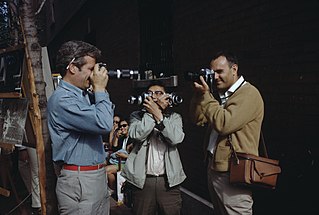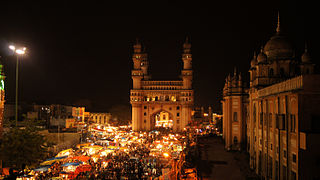
Photography is the art, application, and practice of creating images by recording light, either electronically by means of an image sensor, or chemically by means of a light-sensitive material such as photographic film. It is employed in many fields of science, manufacturing, and business, as well as its more direct uses for art, film and video production, recreational purposes, hobby, and mass communication.

Trafalgar Square is a public square in the City of Westminster, Central London, established in the early 19th century around the area formerly known as Charing Cross. The square's name commemorates the Battle of Trafalgar, the British naval victory in the Napoleonic Wars over France and Spain that took place on 21st October 1805 off the coast of Cape Trafalgar.

An instant camera is a camera which uses self-developing film to create a chemically developed print shortly after taking the picture. Polaroid Corporation pioneered consumer-friendly instant cameras and film, and were followed by various other manufacturers.

Aerial photography is the taking of photographs from an aircraft or other airborne platforms. When taking motion pictures, it is also known as aerial videography.

The Blue Marble is a photograph of Earth taken on December 7, 1972, from a distance of around 29,400 kilometers from the planet's surface.

Photogrammetry is the science and technology of obtaining reliable information about physical objects and the environment through the process of recording, measuring and interpreting photographic images and patterns of electromagnetic radiant imagery and other phenomena.

Photograph manipulation involves the transformation or alteration of a photograph. Some photograph manipulations are considered to be skillful artwork, while others are considered to be unethical practices, especially when used to deceive. Photographs may be manipulated for political propaganda, to improve the appearance of a subject, for entertainment, or as humor.

The Charminar is a monument located in Hyderabad, Telangana, India. Constructed in 1591, the landmark is a symbol of Hyderabad and officially incorporated in the emblem of Telangana. The Charminar's long history includes the existence of a mosque on its top floor for more than 425 years. While both historically and religiously significant, it is also known for its popular and busy local markets surrounding the structure, and has become one of the most frequented tourist attractions in Hyderabad. Charminar is also a site of numerous festival celebrations, such as Eid-ul-adha and Eid al-Fitr, as it is adjacent to the city's main mosque, the Makkah Masjid.

The Temple of Bel, sometimes also referred to as the "Temple of Baal", was an ancient temple located in Palmyra, Syria. The temple, consecrated to the Mesopotamian god Bel, worshipped at Palmyra in triad with the lunar god Aglibol and the sun god Yarhibol, formed the center of religious life in Palmyra and was dedicated in AD 32. The temple would have been closed during the persecution of pagans in the late Roman Empire in a campaign against the temples of the East made by Maternus Cynegius, Praetorian Prefect of Oriens, between 25 May 385 to 19 March 388. Its ruins were considered among the best preserved at Palmyra, until they were further destroyed by the Islamic State in August 2015. The arched main entrance into the temple is still intact, as well as its exterior walls and fortified gate.

Reconstruction in architectural conservation is the returning of a place to a known earlier state by the introduction of new materials. It is related to the architectural concepts of restoration and preservation, wherein the most extensive form of reconstruction is creating a replica of a destroyed building.

Instax is a brand of instant still cameras and instant films marketed by Fujifilm.

Christus is an 1833 white Carrara marble statue of the resurrected Jesus by Bertel Thorvaldsen located in the Church of Our Lady, an Evangelical Lutheran Church of Denmark in Copenhagen, Denmark. It was commissioned as part of a larger group, which includes 11 of the original 12 apostles and Paul the Apostle.

The statue of George IV in Trafalgar Square, London, is a bronze equestrian statue by Sir Francis Legatt Chantrey. It depicts the King dressed in ancient Roman attire and riding bareback. The sculpture was originally designed to sit on top of the Marble Arch at the entrance to Buckingham Palace, but was placed in its current location following the King's death.

Deliberate destruction and theft of cultural heritage have been conducted by the Islamic State (IS) since 2014 in Iraq, Syria, and to a lesser extent in Libya. The destruction targets various places of worship under IS control and ancient historical artifacts. In Iraq, between the fall of Mosul in June 2014 and February 2015, IS had plundered and destroyed at least 28 historical religious buildings. Valuable items from some buildings were looted in order to smuggle and sell them to foreigners to finance the running of the Islamic State.

The Seaman-Drake Arch, also known as the Inwood Arch, is a remnant of a hilltop estate built in 1855 in the Inwood neighborhood of Manhattan, New York City by the Seaman family. Located at 5065 Broadway at West 216th Street, the arch was built from Inwood marble quarried nearby. It is 35 feet (10.67 m) tall, 20 feet (6.10 m) deep, and 40 feet (12.19 m) wide, and was once the gateway to the estate.

Khaled Mohamad al-Asaad was a Syrian archaeologist and the head of antiquities at the ancient city of Palmyra, a UNESCO World Heritage Site. He held this position for over forty years. Al-Asaad was publicly beheaded by the Islamic State on 18 August 2015, at the age of 83.

The Temple of Baalshamin was an ancient temple in the city of Palmyra, Syria, dedicated to the Canaanite sky deity Baalshamin. The temple's earliest phase dates to the late 2nd century BC; its altar was built in 115 AD, and the temple was substantially rebuilt in 131 AD. The temple would have been closed during the persecution of pagans in the late Roman Empire in a campaign against the temples of the East made by Maternus Cynegius, Praetorian Prefect of Oriens, between 25 May 385 to 19 March 388. With the spreading of Christianity in the region in the 5th century AD, the temple was converted to a church.

The Monumental Arch, also called the Arch of Triumph or the Arch of Septimius Severus, was an ornamental archway in Palmyra, Syria. It was built in the 3rd century during the reign of emperor Septimius Severus. Its ruins later became one of the main attractions of Palmyra until it was officially destroyed by the ISIS in 2015. Most of its stonework still survives and there are plans to rebuild it using anastylosis.
Digital archaeology is the application of information technology and digital media to archaeology. It includes the use of digital photography, 3D reconstruction, virtual reality, and geographical information systems, among other techniques. Computational archaeology, which covers computer-based analytical methods, can be considered a subfield of digital archaeology, as can virtual archaeology.
#NEWPALMYRA is an effort to reconstruct the ancient city of Palmyra as an immersive virtual environment, based on archaeological and other clues. The project was started from photos Bassel Khartabil had been taking of Palmyra since 2005. He began building models of the ancient city, with support from Al Aous Publishers. In 2012, Khartabil was arrested, and the original project and open source files were lost. Barry Threw took over as director of the project, renamed #NEWPALMYRA, and a community of developers, modelers, and archaeologists began collaborating to model, restore, and later recreate from scratch those historical structures captured on film and camera.

















